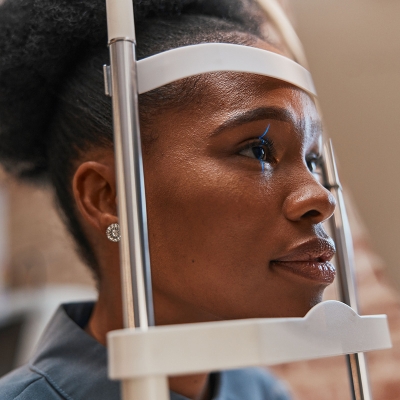Try these types of glasses to help ease eye strain
A person’s eyes sometimes need a break from digital screens — computer glasses and some other types can help. Here’s how.

Nowadays, people spend a lot of time in front of digital screens. That could be at work on computers or laptops, or after hours on tablets or smartphones.
Spending too much time in front of screens can put a lot of strain on the eyes. It can lead to symptoms like discomfort and blurred vision to dry eyes and headaches.
One solution for extended screentime, among others, is computer glasses. These special glasses are designed to lessen the strain and discomfort on the eyes. They can also help a person focus better on their work. Here’s what to know.
Need new glasses for work? In 3 easy steps, you could have a new pair on the way. Check your vision coverage, select your favorite frames, then check out. Done!
What are computer glasses?
Computer glasses are a type that help prevent digital eye strain. They can be particularly helpful for people with presbyopia. This is a common condition that happens as people get older. People who can see at a distance start having trouble seeing things close to them. It typically affects people 40 and older.1
The lenses in computer glasses are designed to focus better on digital screens, like computers or smartphones. A person will typically want the screens to be anywhere from 20 to 26 inches away from their face. These lenses can help:1
- Reduce discomfort in the eyes and blurred vision
- Help the eyes switch focus between different distances, especially at work
People can typically get both prescription and over-the-counter computer glasses. Computer glasses can come in handy for reducing symptoms like:2,3
- Burning or itching eyes
- Double vision
- Dry eyes
- Eye fatigue
- Eye twitching
- Fluctuating vision
- Headaches
- Red eyes
People will want to wear computer glasses with a middle-distance prescription for better comfort.2
What types of lenses for computer glasses can people get?
There are several types of lenses for computer glasses that are available. These include:3
- Single vision. These have lenses with the same power on all parts of the lens. They’re good for both young and older people.
- Progressive. These have no-line multifocal lenses. They have different powers for a person’s far, middle and close vision. They allow a person to have a wider view of their digital screen. They do, however, have a smaller zone of distance vision. So they’re not recommended for driving.
- Bifocal and trifocal. A person might also see these types of lenses called multifocal lenses.1 They have larger zones of vision for middle and close-up vision than normal bifocal or trifocal lenses. (Bifocals have 2 optical powers in one lens, while trifocals have 3.)
What features of computer glasses help reduce eye strain?
Computer glasses may come with several features that can help reduce eye strain:1,3
- Anti-reflective coating. This coating lessens reflections and glare, making it easier to focus on a screen. It can help reduce eye strain and make it easier to see smaller details.
- Blue-light filtering. This can help filter out blue-violet light, a type of light that can lead to eye strain. But at least one review of scientific studies showed that these lenses don’t help improve eye fatigue or strain in comparison to normal lenses.4
- Tinted. Computer glasses can come in different lens tints. These help reduce glare from overhead lighting. An eye care provider might recommend a slight tint for the best results.
What other types of glasses can help reduce eye strain?
If a person can’t see close to them or far away, they might need more than just computer glasses. They will want to take the following steps:
- Book a comprehensive eye exam with an eye care provider
- Get a glasses prescription
- Buy glasses that correct their specific vision issue
Common issues can include:1
- Nearsightedness (myopia) where people have trouble seeing at a distance
- Farsightedness (hyperopia) where people have trouble seeing up close
- Presbyopia (see above)
Besides computer glasses, eye care providers might also recommend people with presbyopia try reading glasses. They might also be called “readers.” They have single-vision lenses, which can help a person’s near vision.
A person can get either prescription or over-the-counter readers. It’s important to talk to an eye care provider about a person’s needs.
What are some ways besides glasses to reduce eye strain?
Computer glasses or prescription eyewear can be one solution. But people can also reduce eye strain by following these tips:5
- Adjust screen brightness and contrast. Make sure the screen is set to a comfortable brightness and contrast level. That’s in addition to keeping the screen the right distance away from a person’s face (see above).
- Blink regularly. This can help keep the eyes moist and reduce dry eyes.
- Give the eyes a break: Focusing too hard on a screen?
- Reduce screen glare. Use a screen protector on your digital devices to help do this. (UnitedHealthcare Vision members can access a discount of 30% off screen protectors for select digital devices with blue light filtration.)
How can a person get the glasses they need to reduce eye strain?
Anyone can get glasses, whether they are computer glasses or prescription ones. But if they have a vision insurance plan, that can make glasses more affordable.
For example, UnitedHealthcare Vision insurance may help cover computer glasses. If a person needs another type of prescription eyewear, they may have an allowance to spend on it. UnitedHealthcare Vision members also have access to discounts on blue light glasses and readers.
UnitedHealthcare Vision offers a huge selection of designer eyeglasses — and vision insurance can help pay for them. Learn more now.
Sources:
- Eyeglasses: How to choose glasses for vision correction American Academy of Ophthalmology, June 2023
- How to find the best computer glasses in 2024 All About Vision, last updated January 2024
- Computer glasses: Custom glasses for computer use All About Vision, last updated July 2023
- Blue-light filtering spectacle lenses for visual performance, sleep, and macular health in adults National Library of Medicine, August 2023
- Computers, digital devices, and eye strain American Academy of Ophthalmology, June 2023


